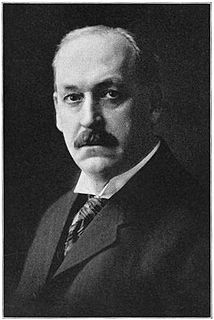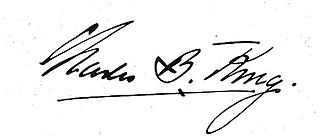
Albert Kahn was an American industrial architect. He was accredited the architect of Detroit and designed industrial plant complexes such as the Ford River Rouge automobile complex. He designed the construction of Detroit skyscrapers and office buildings as well as mansions in the city suburbs. He led an organization of hundreds of architect associates and in 1937, designed 19% of all architect-designed industrial factories in the United States. Under a unique contract in 1929, Kahn established a design and training office in Moscow, sending twenty-five staff there to train Soviet architects and engineers, and to design hundreds of industrial buildings under their first five-year plan. They trained more than 4,000 architects and engineers using Kahn's concepts. In 1943, the Franklin Institute posthumously awarded Kahn the Frank P. Brown Medal.

The Brass Era is an American term for the early period of automotive manufacturing, named for the prominent brass fittings used during this time for such things as lights and radiators. It is generally considered to encompass 1896 through 1915, a time when these vehicles were often referred to as horseless carriages.
K-R-I-T was a small automobile manufacturing company (1909–1916) based in Detroit, Michigan.

Michigan Central Station is the historic former main intercity passenger rail station in Detroit, Michigan. Built for the Michigan Central Railroad, it replaced the original depot in downtown Detroit, which was shuttered after a major fire on December 26, 1913, forcing the still unfinished station into early service. Formally dedicated on January 4, 1914, the station remained open for business until the cessation of Amtrak service on January 6, 1988. The station building consists of a train depot and an office tower with thirteen stories, two mezzanine levels, and a roof height of 230 feet. The Beaux-Arts style architecture was designed by architects who had previously worked together on Grand Central Terminal in New York, and it was the tallest rail station in the world at the time of its construction.
The Boyne City Railroad was a railway based at Boyne City, Michigan, U.S., during 1893–1978.

The Hammond Building was a high-rise building completed in 1889 at the southeast corner of Griswold Street and West Fort Street in the financial district of downtown Detroit, Michigan directly across Fort Street from the Detroit City Hall. The 46 m (151 ft) building was designed by George H. Edbrooke, and is considered the first skyscraper in the city, and was the tallest in the state when built. Russell Wheel & Foundry supplied and erected the iron and structural steel for the building. The Hammond Building was demolished in 1956 to make way for the National Bank of Detroit Building, which has since been renamed The Qube. At 12 stories, the steel-framed United Way Community Services Building (1895), originally the Chamber of Commerce Building, qualifies as Detroit's oldest existing skyscraper.
The SS Anna C. Minch was a cargo carrier which foundered, broke in two, and sank in Lake Michigan during the Armistice Day Blizzard on 11 November 1940. The Anna C. Minch was a steam-powered, steel-hulled bulk freighter constructed in 1903 by the American Ship Building Company at Cleveland, Ohio.
Detroit Auto Vehicle Company was a short-lived early automobile manufacturer established in the summer of 1904 with a capital stock of US$150,000. Based in Detroit in the old Detroit Novelty Machine Company building, it also had a foundry in Romeo, Michigan. It ceased operation in October 1907 following bankruptcy.
The Peninsular Car Company was a railroad rolling stock manufacturer, founded by Charles L. Freer and Frank J. Hecker in 1885.

Clarence Monroe Burton was a Detroit lawyer and businessman, historian, and philanthropist.

Charles Brady King was an American engineer and entrepreneur remembered as an automotive pioneer, artist, etcher, musician, poet, architect, mystic, industrialist and inventor.

The Burton and Ashby Light Railway was a tramway system operating between Burton upon Trent and Ashby-de-la-Zouch between 1906 and 1927.
The Detroit and Charlevoix Railroad is a defunct railroad that was located in Northern Lower Michigan. It was created to haul finished lumber from timber lands to market. It was acquired by the Michigan Central Railroad.

Julius Kahn was an American engineer, industrialist, and manufacturer. He was the inventor of the Kahn system, a reinforced concrete engineering technique for building construction. The Kahn system, which he patented in 1903, was used worldwide for housing, factories, offices and industrial buildings. He formed his own company, Trussed Concrete Steel Company, as a manufacturing source for his inventions. He also founded United Steel Company and was chairman of Truscon Laboratories.
The Eureka Iron & Steel Works was an American iron and steel company in Wyandotte, Michigan. It started in 1853 with the discovery of unusually high-quality iron ore in the Upper Peninsula of Michigan. A group of businessmen in the Detroit area figured this could be a profitable enterprise to manufacture iron and steel, so they pooled together funds to form a new company. The company produced the first commercially available steel in America. One of the first uses for this steel was tracks for railroads. It was in business until 1892.
Michigan Stove Company was originally an enterprise started by Jeremiah Dwyer and his brother in the mid nineteenth century. Their career background training was in the foundry business. They started a Detroit, Michigan company that eventually developed into a joint stock company called the Detroit Stove Works. Dwyer reorganized this firm in 1871 with another set of investors and it became the Michigan Stove Company. They manufactured cooking stoves, heaters, and furnaces under their "Garland" brand. The company was known for its state of the art technology in foundry applications. It was considered to be the world's largest producer of stoves and ranges with its 700 styles and sizes. The company had branch offices in the largest U.S. cities, as well as global distribution arrangements.

Jeremiah Dwyer was an American businessman, industrialist, and manufacturer in Detroit, Michigan. He was associated with stove manufacturing for over five decades. Known as "The Stove King", Dwyer developed his first stove company in 1861. His firm later became the Detroit Stove Works as a joint stock company becoming a successful enterprise. That was reorganized later again with additional investors becoming Michigan Stove Company, the world's largest producer of stoves at the time. Besides running this company he was also a director of several other stove companies as well as a board member of several businesses in the Detroit area.

William J. Keep was an American mechanical engineer who worked with molten metals in foundries. He mixed aluminum and other elements with iron to come up with new alloys with different characteristics that were used for stoves and heaters. He was known as a consulting engineer to the Michigan Stove Company that was founded by Jeremiah Dwyer.










